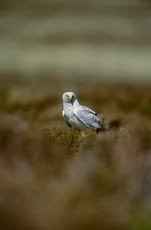
Today - the 'Glorious Twelfth' - marks the start of the red grouse shooting season.
The attendant media coverage that this once-a-year festival generates also spurs a lot of people to ask the RSPB what it thinks about shooting. At first, it might be tough to see what shooting and conservation have in common. After all, one is interested in killing birds, while the other wants to protect them - right?
But the truth is that the two interests have a lot more in common than you might think. Responsible shooters have a basic love of nature, as do conservationists. At a more practical level, both shooting and conservation rely on well-managed habitats to thrive, something which can benefit a wide range of wildlife.

It's not all plain sailing though. It's true that many areas managed mainly for shooting are also good for other wildlife. But there are some cases where shooting management overly favours the species being shot at the expense of all others. And this simply stores up environmental problems for the future.
The biggest problem, however, both for both shooters and conservationists, is the minority who choose to break the law and kill birds of prey in an attempt to boost the number of game-birds.
One hundred years ago, Victorian approaches to shooting made persecution like this the norm for birds of prey - dark days, which saw four raptor species driven to extinction in the UK: marsh harriers, goshawks, white-tailed eagles and ospreys. Happily, all four are now back in our skies, and wildfowlers along with most lowland shoots now live and work alongside birds
of prey.
of prey.
But the story isn't so rosy everywhere. Scottish Natural Heritage, the Scottish Government's wildlife authority, has stated that persecution associated with grouse moors is the main factor affecting the conservation status of the golden eagle. In England, hen harrier numbers are restricted to only a handful of pairs every year, when there is room in our uplands for hundreds.

The illegal killing and disturbance of birds of prey remains an unacceptable throwback to an out-dated way of managing the countryside. The fact that there are more peregrines nesting in our city centres than there are in the Peak District speaks volumes. Unfortunately, as birds of prey are by their very nature rare, it only takes a few illegal acts to wreak disproportionate damage - just as it only takes a few lawless individuals to bring the whole shooting community into disrepute. This simply serves to drive a wedge between the shooting and conservation communities.
It's therefore in everyone's interest - shooters, conservationists and the general public - that these selfish few are found out and brought to book.
The RSPB's bird of prey campaign aims to do just that, demanding an end to the illegal killing of birds of prey. It's very encouraging that several shooting organisations, including the British Association for Shooting and Conservation and the National Gamekeepers Organisation, have signed the pledge, as well as over 140,000 concerned individuals.
Please, help us root out the few bad apples and save birds of prey, by adding your voice (click here).
GUEST BLOGGER: Sue Armstrong-Brown, Head of Countryside and Species Conservation at the RSPB.
Images: Andy Hay (rspb-images.com)
1 comment:
Sue,
It sounds like you do not actually mind if people killing birds, as long as there are enough other birds around of the same species.
If you actually do object to shooting birds, say so.
If you don't, perhaps the RSPB should call itself something else. Perhaps the 'P' could stand for ... 'Penetrating'? 'Popping'? 'Polishing off'?
Cheers,
Bill
PS: I know that guest bloggers don't always come back to read comments. I hope you will.
Post a Comment